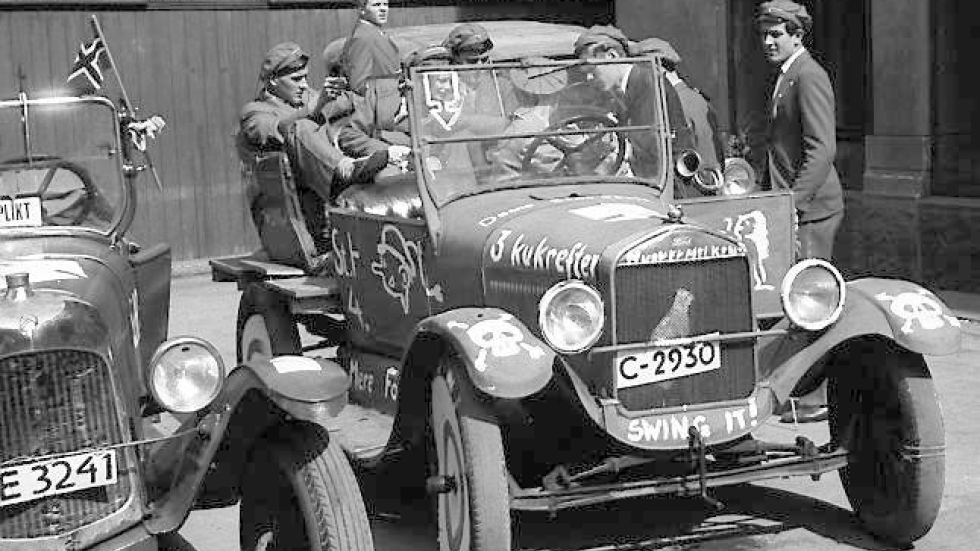Today’s blog post was inspired by my niece Synne, who is graduating high school this month and is pictured in the feature image (she is the lovely young woman on the very left). Seeing her photos made me reminisce back to when I was celebrating finishing school in Norway and having fun being a “russ”. Even though the American tradition of prom has somewhat seeped into the Norwegian culture, it’s the “russ” time that still dominates at home.
If you’ve ever found yourself in Norway around the national Constitution day on May 17th, you may have seen huge parades of people marching on the street. Intermixed in the crowd, you might spot a number of tired, ragged looking teenagers dressed in red or blue overalls with writings all over them. Who are these people and why are they dressed like this??
This a phenomena called “russ”, a nationwide term that describes high school graduate students and has been a country wide celebration for over 100 years. Historically the word is built on a Danish tradition stemming all the way back to the 18th century where university students called themselves ‘russ’ or ‘rus’. Back then, Norway didn’t have their own universities, and Norwegian students who were interested in educating themselves further, would have to travel to Denmark. To be able to begin the studies, one would have to pass an initial exam, called examen artium, and when the exam papers were handed in, students were given a horn to wear on their forehead. Only when the results of the exam came back and students passed, was the horn removed from their forehead, and they went from “wild animals” to civilized students. The word “russ” stems from the Latin term “cornua depositurus”, which means to ‘to put away the horns.’
Examen artium was later moved to the high school and the term ‘russ’ followed along with it.
Initially, the russ celebration were for the upper class, elite population and their children only. In 1905 only 300 students graduated and completed their exams, while today over 40,000 high school students graduate.
Image from wikimedia of the russ celebration in the 1940s:

The russ culture has always been dominated by the idea of breaking with society’s norms and rules. It’s when young adults get a ‘carte blanche’ in many ways to act out, be a little crazy and do things out of the ordinary.
While the tradition is present both in Denmark and in Sweden, the Norwegian celebration is definitely unique and much grander than in their neighboring countries.
Customarily students dress in red overalls, make up new names for themselves based on their individual personalities, group together to buy red vans they drive around in during this period, make their own “business cards” they hand out to younger kids and others, gather at big events throughout the country, party and stay out late or all night during the entire month of May (and then some), create and organize a comedic play they act out on stage and invite friends and family to attend, put together a special newspaper with articles and description of each student that will be published and sold on May 17th, come up with special rules and ‘dares’ to accomplish to collect items in the tassels of their hats corresponding with their deeds, and so forth…
Speaking of the latter, a lot of these dares and rules historically involved a lot of alcohol related ‘tasks’, some of which potentially were really dangerous so they have been cracked down on . Other rules have involved illegal actions, hence they have garnered a lot of criticism in the press and among people. A few examples include:
- drink 24 bottles of beer in 24 hours (you get a beer cap in your tassle)
- drink a bottle of wine in 30 minutes (you get a wine cork in your tassle)
- run naked down the street
- walk into a store and ask for condoms without speaking
- stay awake for 24 hours without sleeping
- go swimming in the ocean before May 1st (you get an ice cream pin)
- stand up every 5 minutes during class at school and yell “cheers!”
- walk around for an entire day wearing loaves of bread for shoes
- sit in class wearing only underwear for an entire hour
- make out with a freshman in high school
- spend the night in a teacher’s yard or hallway/entrance
Plus a lot of other rules that may or may not offend the reader… ha! There is also a group of students who elect to be “kristen russ” (i.e Christian russ), who don’t participate in drinking alcohol or sexual games. They are often referred to as “krussen”.
Why does alcohol have such a prevalent part of the russ celebration?
During the early 1900s ,the children of the elite would protest against the temperance movement by drinking publicly during the 17th of May celebration. Even then the russ were obsessed with breaking society’s rules. Today, alcohol is still an important part of the festivities; it creates community and fun among students, and serves as an ‘excuse’ to experiment with your identity, social relations and cultural boundaries. The act of drinking is also a visible symbol of removing yourself from the label as a child and student to entering adulthood.
The russe period very much signifies the transition from child to adult, much like a confirmation. The beginning of the celebration begins with a baptism; where each ‘russ’ student is baptized and given a new name, and removes all outer characteristics such as individual clothing and style, and replaces it with the overall and cap. The students then move into a phase where everything is legal and rules are there to be broken.
Oh, and each year the russ have an official song. You can listen to this year’s song HERE.
Here is a photo of one of the earliest russe vans:

(Photo from dagsavisen.no)
And here is how it has evolved, this is from the 1980s:

Shops and businesses will sponsor the students’ vans if they get their names and details listed on the cars, which is a great way to pay for the van. Today the buses can be a whole lot bigger and more luxurious, here’s a snap of what one may look like inside:

(Photo from midtsiden.no)
So what about the very peculiar clothing?
The russe cap was first introduced in 1905, when red graduation caps were worn by graduates of higher schooling in Kristiania. The hats were initially only worn by boys, who again were inspired by German students who wore red caps when visiting Norway in 1904. The overalls and buses/vans didn’t arrive until the 1970s and today are highly influenced by clothing manufacturers and commercial equipment companies.
Why overalls?
It was meant to show solidarity with the workers, symbolic of the radical times in the 70s. The students will wear their overalls and caps every single day for the month of May until graduation, which happens right after May 17th, which officially marks the end of the celebration.
Now doesn’t this sound a whole lot more fun than stressing over getting a date and buying the perfect dress /gift for prom?? Comment below and let me know what you think!









We don’t have proms or anything as crazy as this here in Belgium! Ha!